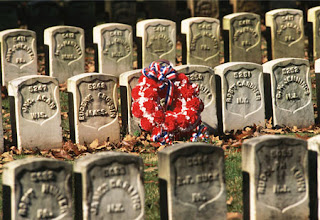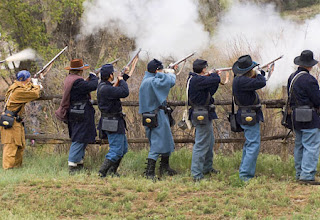America’s Must-See Civil War Sites: Washington, D.C.
America’s Must-See Civil War Sites: Gettysburg
This
battlefield in south-central Pennsylvania was the turning point of the
war — specifically, most historians say, when Pickett’s Charge was
turned away at Cemetery Ridge on July 3, 1863. You can stand at the
very spot today and consider alternative histories had the charge
succeeded; stroll the grounds where Lincoln declaimed his famous
10-sentence speech five months later. (Read the text of the Gettysburg
address.) The battlefield itself and surrounding countryside are
surpassingly lovely and serene, and it’s almost impossible to conceive
the conflagration that took place here.
The
Confederacy’s most notorious prison camp housed as many as 45,000
Union troops in southern Georgia; almost one-third died of disease,
malnutrition and exposure in the confine known as Camp Sumter. When
Congress designated it as the Andersonville National Historic Site in
1970, it expanded the scope of the park to honor all American
prisoners of war, in all wars, and to examine POW camps throughout
history. Today as beautiful and peaceful as any pastoral countryside,
it’s a sobering place to reflect on the genesis and meaning of the
Geneva Conventions meant to protect the victims of war.
The
westernmost battle of the war took place here, 20 miles east of Santa
Fe, in the foothills of the Sangre de Cristo Mountains in late March
1862. When Union forces under Col. John Chivington overwhelmed several
Texas regiments, Confederate visions of Western advance ended. The
pine and grassland scene today is a breeze-swept transition between
the High Plains and Southern Rockies. And, yes, the northern commander
was the same John Chivington who led the slaughter of 150 defenseless
Cheyenne Indians at Sand Creek, Colo., in 1864.
America’s Must-See Civil War Sites: Vicksburg, Miss.
Vicksburg, with
high bluffs overlooking the Mississippi River, was the key city on the
southern portion of the river. Union forces under Gen. Ulysses Grant
attacked and then besieged the city in May and June 1863. When
Confederate defenders surrendered on July 4, control of the Mississippi
and its vital shipping lanes passed to the North for the remainder of
the war. Standing on those bluffs today, it’s instructive to
recognize the significance of the river, then and now, in American
affairs. The nearby Natchez Trace Parkway is one of America’s most
beautiful drives, a peaceful journey through rolling Mississippi
fields and forests.
The
Tennessee city that lies beneath Lookout Mountain was the focus of some
of the war’s fiercest and most important battles in the fall of 1863.
First came a Confederate victory at Chickamauga in northern Georgia,
then a battle and siege in and around Chattanooga that was eventually
won by Grant that November. The national military park that
encompasses both battlefields is an immense complex, mostly preserved
in its historic configuration, as it was the first U.S. military park
in 1890. Chattanooga is one of the South’s most cosmopolitan urban
centers, with a symphony, theater, a thriving art district, numerous
visitor attractions and a lengthy riverfront trail system.
America’s Must-See Civil War Sites: New Haven, Conn.
For more than
three centuries, cargo ships sailed the Atlantic with slaves brought
west from Africa in chains — up to 20 million, some historians
estimate. The U.S. slave trade ended in 1808, despite the continuation
of slavery, but slavers continued to sail. The Amistad America, whose
home port is New Haven, is a reconstruction of a famous slaver
(pictured here docked in nearby Mystic) that was seized by its
captives in a rebellion and captured off Long Island, leading to an
1840 U.S. Supreme Court decision acknowledging their right to be free.
Slavery is alive today in many parts of the world; Hillary Clinton has
made abolishing human trafficking a key tenet of her work as
Secretary of State.
The war
began in earnest near Manassas, Virginia, on July 21, 1861, in a
battle whose two names still betray divisions between North and South:
After all this time, it’s called Bull Run in the North, First
Manassas in the South. The Union forces lost, but a far more
meaningful event took place here a half-century later, on July 21,
1911, when veterans of the battle met to shake hands in the Peace
Jubilee. That’s what community leaders in Manassas’ Prince William
County have chosen to re-enact this summer: On July 21, Manassas will
re-create the 1911 Jubilee, and celebrate peace and reconciliation.
America’s Must-See Civil War Sites: Pea Ridge, Ark.
Although
most Civil War fighting took place east of the Mississippi River — and
most of that was in Virginia — the battle along a set of hills in
northwestern Arkansas in early March 1862 proved a pivotal moment.
Here, far from the main theater of war, a smaller Union army defeated a
larger Confederate force, thereby assuring that Missouri was a Union
state, and basically ending Southern hopes for success west of the
Mississippi. Set in the foothills of the Ozarks, Pea Ridge
National Military Park is a lovely place to visit in autumn, when the
area’s oak and maple forests are in fall color, and one can hardly
believe a different crimson once covered the ground.
America’s Must-See Civil War Sites: Harper’s Ferry, W.V.
Few events
in American history are as bizarre as abolitionist John Brown’s
October 1859 raid on a federal weapons arsenal in this then-Virginia
town on the Potomac River. Brown hoped he would spark a slave revolt
in the South; instead, he was captured — ironically, by Robert E. Lee —
tried and hanged for treason. At his execution he declared: “I John
Brown am now quite certain that the crimes of this guilty land will
never be purged away but by blood.” Visitors today can see the armory
“fort” in which Brown and his raiders tried to hold off federal
troops.
America’s Must-See Civil War Sites: Huntsville, Texas
A few
Confederate leaders, including Lee, fought not for slavery but for
their own notions of regional loyalty. What’s far less known is that
some Southern leaders spurned the Confederacy, period. Sam Houston,
former governor of Tennessee, legendary “father” of Texas independence
and two-term Texas president was, in 1861, governor of the Lone Star
State. He opposed secession and refused to swear a Confederate oath of
loyalty. The Texas legislature booted him from office and he died in
figurative exile in 1863. This little-known story of courage is told at
the Sam Houston Memorial Museum in Huntsville, his last hometown, a
pretty, oak-shaded university town halfway between Dallas and the huge
city that now bears his name.
America’s Must-See Civil War Sites: Cincinnati
Hundreds
of thousands of black slaves attempted to reach freedom in the North
or, better, Canada, before Lincoln’s 1863 Emancipation Proclamation.
The Underground Railroad was an escape network that operated before
the Civil War, consisting of freedom supporters who helped slaves
reach free states, British territory where slavery had been abolished
or Mexico. The safe houses, tunnels and other secret routes are
explained at the National Underground Railroad Freedom Center in
Cincinnati, which was one of the network’s key transfer points.
America’s Must-See Civil War Sites: Chancellorsville, Va.
Just two
months before the battle at Gettysburg, Confederate forces led by Gen.
Robert E. Lee won a major victory at Chancellorsville, defeating
Union Gen. Joseph Hooker despite superior Northern forces. The peak
day of the battle, May 3, 1863, is often reckoned the second-deadliest
day in the war, and the name Chancellorsville still evokes the awful
horror of battle. Confederate Gen. Stonewall Jackson died here; Hooker
was relieved of command just before Gettysburg; and the Confederate
cause that had seemed riding high after Chancellorsville turned
hopeless just a few months later. Stephen Crane’s famous book, “The
Red Badge of Courage,” is set at Chancellorsville.
Four
years of dreadful conflict finally came to an end in this peaceful
hamlet — little more than a dozen buildings and two streets — in the
Virginia countryside on Palm Sunday, April 9, 1865. At the Appomattox
Courthouse, Gens. Grant and Lee met and negotiated a simple and
compassionate surrender that allowed soldiers on both sides to set
their guns aside and return home. The village rests beneath ancient
oaks and locust trees atop a small hill far from any disturbance,
modern or historic. Visitors today can receive the best souvenir of
Civil War heritage travel, evocative copies of the safe-conduct pass
that Grant’s officers gave Confederate soldiers: “… Permission to go
home, and there remain undisturbed.”
















